PR-6171IRE Science A STEM Approach - 1st Class
Create successful ePaper yourself
Turn your PDF publications into a flip-book with our unique Google optimized e-Paper software.
Earth and the Environment<br />
IN THE SKY AND ON THE LAND<br />
<strong>STEM</strong> project Project<br />
<strong>STEM</strong> Project:<br />
Teacher Notes<br />
Pupils design a day and night scene for a video game using Toondoo and use a video to explain<br />
the scenes and how the video game character interacts with the scenes.<br />
Estimated duration: 2–4 weeks<br />
1. Introduce the project<br />
• Pupils share what video games they have<br />
played. Can you describe what scenes<br />
are in the game? Are they in the day or<br />
the night? What kind of features are in the<br />
scenes? Natural? Constructed?<br />
• Make a T-chart of natural and constructed<br />
features as suggested by the pupils.<br />
• Read the project brief on page 160.<br />
2. Investigate<br />
• View the website as a class. It will be helpful to set<br />
up a login account and give the password<br />
details to pupils when it is their turn to<br />
explore the website in pairs. You may also<br />
wish to pre-prepare a scene to show pupils<br />
what can be done in Toondoo. You can use<br />
DoodleR to free draw or select appropriate<br />
backgrounds and props from the icon<br />
buttons.<br />
• Allow pupils one or two lessons to play<br />
around with Toondoo and familiarise<br />
themselves with how the program works<br />
and all of the icon buttons so they can view<br />
the images and scenes contained within<br />
the program. It is flash based so will only be<br />
accessible on a computer.<br />
• Teachers may wish to use an alternative<br />
program or application.<br />
3. Design, plan and manage<br />
• Pupils select a character in Toondoo and<br />
sketch a rough plan of what their scene will<br />
look like based on this character; i.e. if they<br />
choose a queen as their character then the<br />
background may include a castle, river and<br />
bridges that they need to cross or collect<br />
gems to earn points. A template is provided<br />
on page 163.<br />
• Pupils list what features they want to<br />
include in their day and night scene using<br />
the Venn diagram on page 162. Will some<br />
of the features used in the day scene be<br />
used in the night scene too?<br />
• Pupils write a brief synopsis for their<br />
game using page 164, including how the<br />
character needs to move and what the<br />
character needs to achieve in the day and<br />
night scenes, in order to aid them with their<br />
description for the video presentation to be<br />
recorded later.<br />
4. Make<br />
• Pupils create a day scene and night scene<br />
using Toondoo. Each scene must include<br />
at least one natural and one constructed<br />
feature.<br />
5. Evaluate and refine<br />
• Pupils check that their morning and night<br />
scenes contain at least one natural feature<br />
and one constructed feature, and are<br />
appropriate for day and night landscapes<br />
and skies. Then they will need to make the<br />
appropriate changes.<br />
6. Communicate<br />
• Pupils save and print out their final version<br />
of their day and night scenes from Toondoo<br />
and glue them onto card.<br />
• Pupils record a video explaining their video<br />
game, character and what they need to do<br />
in the day and night scenes, and what part<br />
the features play in the scene. Alternatively,<br />
they can write a script explaining what<br />
happens in each screen.<br />
• Set up a classroom display of the printouts<br />
of the scenes created in Toondoo, or view<br />
the saved files online in your Toondoo<br />
account. Share the videos with the class<br />
and discuss any unusual features for the<br />
day and night landscape and sky. The video<br />
can also be shared via email or submitted<br />
to the school website for friends and family<br />
to watch.<br />
Viewing sample<br />
Prim-Ed Publishing – www.prim-ed.com 978-1-912760-15-2 <strong>1st</strong> <strong>Science</strong>: 159<br />
CLASS<br />
A <strong>STEM</strong> AP<strong>PR</strong>OACH

















